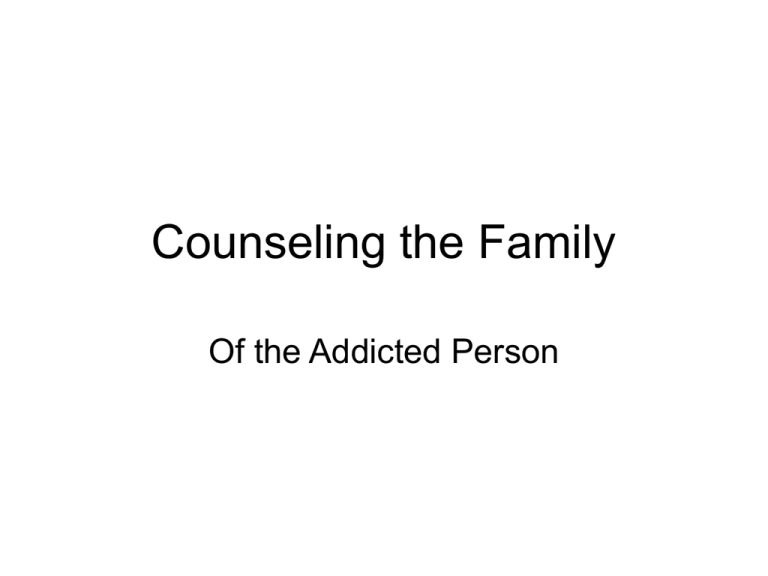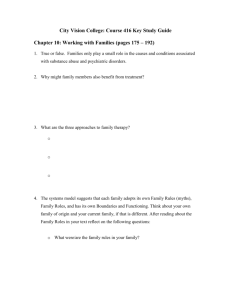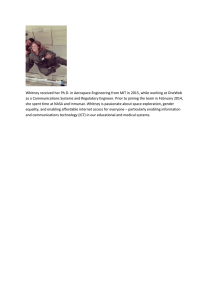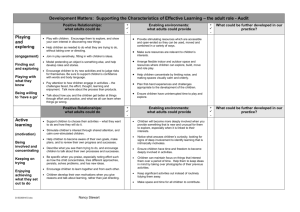Counseling the Family of the Addict
advertisement

Counseling the Family Of the Addicted Person Addicted to Love • http://www.youtube.com/watch?v=3p8Hgr pGvX8 Codependence • Codependence is a pattern of detrimental, behavioral interactions within a dysfunctional relationship which is regarded as an emotional disorder, and by some as a psychological disease.[1] In the relationship, the codependent person is controlled or manipulated by another who is affected with a pathological condition, such as drug addiction.[2] • The codependent's life gets more and more out of hand and at the end, they might become as sick as the one they are codependent on.[3] • In general, the codependent is understood to be a person who perpetuates the addiction or pathological condition of someone close to them in a way that hampers recovery. This can be done through direct control over the dependent, by making excuses for their dysfunctional behavior or relieving them of the consequences of the dependence. • http://www.youtube.com/watch?v=7meE5t pus3Y • http://www.youtube.com/watch?v=4N5R_7 Y3rWg&feature=related Enabling • This is called enabling, which can have negative social and health consequences for both parties. A codependent may feel shame about, or try to change, their most private thoughts and feelings if they conflict with those of another person. Enabling is a term with a double meaning • As a positive term, it references patterns of interaction which allow individuals to develop and grow. These may be on any scale, for example within the family,[1] or in wider society as "Enabling acts" designed to empower some group, or create a new authority for a (usually governmental) body. In a negative sense, • enabling is also used in the context of problematic behavior, to signify dysfunctional approaches that are intended to help but in fact may perpetuate a problem.[1][2] A common theme of enabling in this latter sense is that third parties take responsibility, blame, or make accommodations for a person's harmful conduct (often with the best of intentions, or from fear or insecurity which inhibits action). The practical effect is that the person themselves does not have to do so, and is shielded from awareness of the harm it may do, and the need or pressure to change. It is a major environmental cause of addiction.[3] • A common example of enabling can be observed in the relationship between the alcoholic and a codependent spouse. The spouse believes incorrectly that he or she is helping the alcoholic by calling into work for them, making excuses that prevent others from holding them accountable, and generally cleaning up the mess that occurs in the wake of their impaired judgment. In reality what the spouse is doing is hurting, not helping. Enabling prevents psychological growth in the person being enabled and can contribute to negative symptoms in the enabler. Generally, individuals who enable others have weak boundaries, low self-esteem • and have difficulty being assertive when they communicate with others. Imagine how these characteristics could play out in parenting. A young child wants candy early in the morning. The parent understands that this will not be a good habit to begin and tells the child "no." The child proceeds to throw a fit and the parent has a choice to give in or hold firm. The effect of giving in is profound. • . The child would learn that throwing a fit works, to manipulate others, would not learn how to delay gratification, would have less tolerance to structure such as boundaries in relationships, etc. The short term gain of getting the child to cease his or her fit would not be worth the long term consequences that this experience would mean for their development. Likewise, feeling needed as an enabler is not worth the long term ramifications created by the enabling. The person being enabled will have some difficult short term consequences if the enabling stops, but these experiences are vital to their growth and psychosocial functioning.




